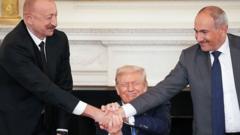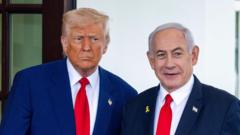Hours before tariffs were set to rise, the US and China extended their trade agreement, allowing for continued negotiations on key issues like technology and market access while alleviating immediate economic pressures.**
US-China Trade Truce Extended as Tariff Deadline Looms**

US-China Trade Truce Extended as Tariff Deadline Looms**
US and China announce a 90-day extension of their trade truce, averting a significant tariff increase that could exacerbate trade tensions.**
The United States and China have reached a temporary reprieve in their ongoing trade tensions by extending their tariff truce for an additional 90 days, just before a significant tariff hike was scheduled to take effect. President Donald Trump signed an executive order on Monday, affirming the continuation of an agreement established in May, which had previously led to a suspension of tariffs on certain goods exchanged between the two nations.
The impending increase in tariffs had raised concerns among U.S. officials, who had warned that if the truce were not prolonged, new tariffs could have detrimental impacts on both economies. In discussions held last month, officials from both countries characterized the negotiations as “constructive,” with China’s lead negotiator emphasizing their commitment to maintaining the truce. Trump’s administration awaited his approval for the extension, highlighting the ongoing unpredictability surrounding trade policies.
The surge in trade tension between Washington and Beijing escalated in April when the U.S. announced a broad series of tariffs on numerous imported goods, disproportionately affecting Chinese products. In retaliation, Beijing implemented its own tariffs, triggering a series of escalatory measures that could have paralyzed bilateral trade. The initial agreement reached in May allowed for some tariffs to be set aside, while still imposing a steep 30% tariff on a range of Chinese goods entering the U.S. and a new 10% tariff on U.S. products entering China.
Ongoing discussions between the two powers are focusing on various contentious issues including China’s access to rare earth resources, its dependency on Russian oil, and U.S. restrictions on the sale of advanced technologies such as microchips to Chinese entities. Recently, Trump relaxed some existing export controls, enabling companies like AMD and Nvidia to again engage in trade with Chinese firms as long as they agree to share a portion of their revenues with the U.S. government.
Moreover, the U.S. is persisting in its demand for the divestiture of TikTok from its parent company, ByteDance, a request that remains opposed by Chinese authorities. Despite the truce, the effects of the trade war have already impacted trade flows, with data indicating that U.S. imports from China plummeted nearly 50% in June compared to the same month last year. In the first half of 2023, U.S. imports from China totaled approximately $165 billion, showing a significant decline of 15% year-over-year, while U.S. exports to China also fell by around 20% during this period.
The impending increase in tariffs had raised concerns among U.S. officials, who had warned that if the truce were not prolonged, new tariffs could have detrimental impacts on both economies. In discussions held last month, officials from both countries characterized the negotiations as “constructive,” with China’s lead negotiator emphasizing their commitment to maintaining the truce. Trump’s administration awaited his approval for the extension, highlighting the ongoing unpredictability surrounding trade policies.
The surge in trade tension between Washington and Beijing escalated in April when the U.S. announced a broad series of tariffs on numerous imported goods, disproportionately affecting Chinese products. In retaliation, Beijing implemented its own tariffs, triggering a series of escalatory measures that could have paralyzed bilateral trade. The initial agreement reached in May allowed for some tariffs to be set aside, while still imposing a steep 30% tariff on a range of Chinese goods entering the U.S. and a new 10% tariff on U.S. products entering China.
Ongoing discussions between the two powers are focusing on various contentious issues including China’s access to rare earth resources, its dependency on Russian oil, and U.S. restrictions on the sale of advanced technologies such as microchips to Chinese entities. Recently, Trump relaxed some existing export controls, enabling companies like AMD and Nvidia to again engage in trade with Chinese firms as long as they agree to share a portion of their revenues with the U.S. government.
Moreover, the U.S. is persisting in its demand for the divestiture of TikTok from its parent company, ByteDance, a request that remains opposed by Chinese authorities. Despite the truce, the effects of the trade war have already impacted trade flows, with data indicating that U.S. imports from China plummeted nearly 50% in June compared to the same month last year. In the first half of 2023, U.S. imports from China totaled approximately $165 billion, showing a significant decline of 15% year-over-year, while U.S. exports to China also fell by around 20% during this period.



















